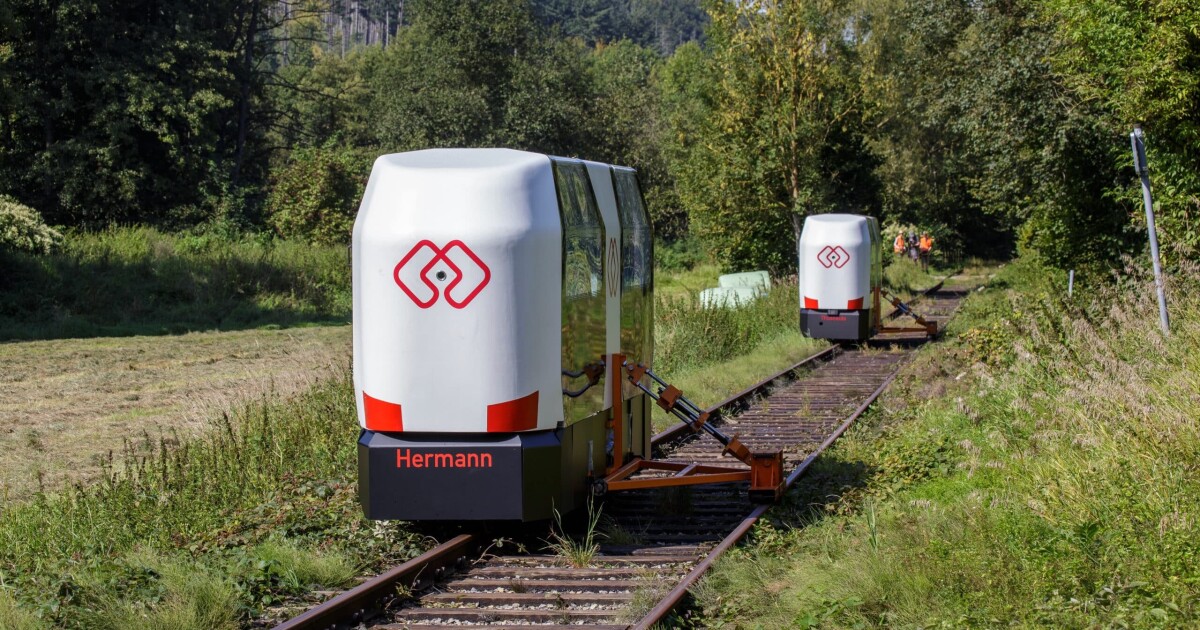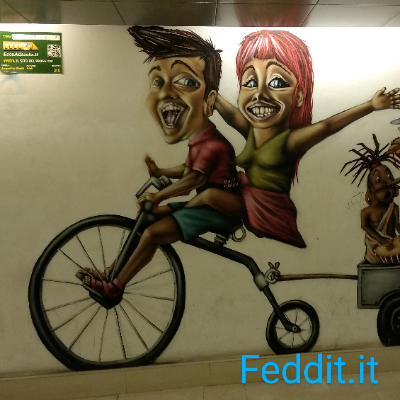Looks like they could totally fit a bike rack on these things too!
I’ve always liked the concept of the gyro monorail, as it avoids the requirement to use elevated track that standard monorails have.
That said, I’m skeptical whenever rail is used for really short railcar configurations (ie a single car). Trains are not just wagons on low-friction tracks, but act as a streamlined unit, only incurring the burden of air resistance once.
This pod design is more-or-less just using the tracks as a traction surface and a guideway. But robotics students everywhere will know that we can build land vehicles which follow markers on the ground, avoiding LIDAR, RADAR, or any other such complexities that self-driving automobiles seem to keep butting up against.
They may have a point, if the goal is to reuse abandoned rail lines as-is, but the focus on reuse seems to miss the alternative solution: 4-wheel pods that steer along a rail-to-trail path. Compared to this self-balancing rail pod, I have to imagine developing or adapting an existing, narrow 4 wheel vehicle is going to be easier and cheaper to maintain. Any concerns about the vehicle steering itself off the path would be similar to concerns about a gyro pod failing to negotiate a curve: both scenarios would go off path. But at least 4 wheel pods would remain upright, while a balancing pod would topple or roll-over.
There’s also the whole issue of head-of-line blocking, since without a passing track, every pod behind must wait for passengers to board the pod ahead. Unless they build out the rural “stations” with sidings. But again, at that point, just convert to a trail. No stations or sidings needed.
Two-way pod traffic could still leave enough room for a separated, single-lane of recreational pedestrian or bicycle traffic, which might make sense in rural areas. I’m weary of suggesting that pods and bicycles should share the same lanes though, because then we’re back to whole anti-collision issue vis-a-vis self-driving automobile. Two lanes for pods and one lane for bikes/pedestrians is still an improvement over zero lanes and abandoned trackage.
I like where the conversation is going, reclaiming old rights-of-way to better accommodate public needs. But I have to imagine German rail corridors are sufficiently wide for more than a narrow, self-balancing “pod way” and should incorporate other linear transportation ideas while pursuing novel ideas.
I think you make some good points.
Most importantly, the hard part of these projects is the right of way. I agree that it should be used to its greatest advantage. I suspect you could rip these rails up, lay down kiddie train rails and a bike path for the same price.
The biggest reason for standard monorails is grade separation.
The burden of air resistance is negligible at these speeds. The rolling resistance, lifespan, and pollution of rubber tires is a disadvantage, but at these speeds it is probably the best use of rubber tires.
You only need two lanes for pods at passing tracks. The need for continuous two way traffic probably means the capacity has outgrown this solution.
You also have good points. As it happens, near my metro area is a park which does indeed have a children’s railroad that both crosses and then parallels a major bike trail. And it’s absolutely adorable.
The point re: rubber rolling resistance and pollution is well taken. But I don’t think the air resistance is negligible here. I realized now that the linked article doesn’t describe the speed of this monorail, so I had assumed it was something like a sauntering 30 kph (18 mph), which if available 24/7/365 from rural areas into the urban core and had consistent on-time performance, that’d be excellent.
But this other article lists the speed for these pods as 60 kph (37 mph). That’s kinda terrifying for a pod, where just the gyro components weigh 650 kg (1433 lbs), and definitely implicates air resistance. At that speed, the gyro had better be robust enough to counter sudden winds that would threaten to tilt one pod into the path of an oncoming pod.
Now that I think of it some more, on a horizontal curve, roads will widen the lanes so that vehicles won’t side-swipe each other. And tracks are set farther apart than on straightaways, for the same reason. But the pair of rails? They’re always 1435 mm (4 ft 8.5 in) apart, so will the pods be designed for a maximum curve speed and angle, or will passing be disallowed on curves?
Finally, I will concede that requiring two way pod lanes would definitely be a success story. But seeing as they’re planning to use abandoned trackage, even a single-track railroad will already provide two “lanes” for their pods for free. If they had right-of-way that doesn’t have existing track, it’s not clear if their plan is to install a single rail.
EDIT: I forgot the other article’s link: https://update.phoenixcontact.com/en/balancing-act-on-the-rail/
I would say 30kph would be plenty especially for nonstop on-demand service. 60kph sounds unrealistic.
The reason I think you could lay new track is that kiddie train track is really cheap and used railroad rail is pretty valuable.
The value of a scrap railroad track varies by material and its condition. Depending on its dimensions and shape, a ton can range from $300 to $750. For example, an R50 track will fetch a price of between $200 and $750, while an R65 way will cost more than twice that.
It would be simple to make self driving golf carts that followed a magnetic or inductive guideway or even used a virtually guideway with gps. There are a few of these available off the shelf right now. One I remember is dutch and there was another produced in Great Britain.
The reason I think you could lay new track is that kiddie train track is really cheap and used railroad rail is pretty valuable.
Railroad track is certainly valuable, although its removal and rehabilitating the rail bed can add up. Here in the USA, a number of disused railroads are simply left in place, usually only removing the points which connect to the mainline. I’m informed that part of the reason is due to regulations that make it hard to re-establish a rail segment if the rails are fully dismantled. I also have to imagine that if the rails are too valuable, unscrupulous scrap dealers would have made off with them already.
I certainly agree that any track used in service of a self-balancing pod has better of good or excellent quality, since we absolutely do not want pods coming off due to a rail issue.
I do like that all these ideas are essentially recreating the lazy river experience, but with no inflatable donuts lol
P.S. I added the right link to my last post; I forgot to paste it earlier
Rail is hard to steal because it is hard and heavy. Look at the price of small sections used for anvils. It was a shock for me.
I participated in a exploration of PRT that was done by someone at University of Washington a few decades ago. One of the things discussed was the comparison of travel times between slow PRT and fast light rail. It doesn’t take many 60-90 second stops to really slow your average speed.
It’s kinda like that brain teaser: If a race car does the first lap at 60 miles an hour how fast does he have to go on the second lap to average 120.
Something that stuck with me from at least a decade back was multimodal transit, aka cars that can become trains and vice versa. Imagine driving your low speed cargo pod car thing to the local train station and hitching together with a bunch of others before making the hour trip to a neighboring city on rails at high speed only to split up automatically at the other end and continue to your separate destinations. Its a combination of the efficiencies of transit and the freedoms of an individualized last mile solution. It reduces the need for freeways without hurting mobility at the origin/ destination.
It’s a plausible idea, although admittedly it only solves one of the automobile-specific drawbacks and leaves the other issues unaddressed. Road trains show that coupling separate vehicles together yields efficiencies for the few, large prime movers, when compared to several small engines. Moving vehicles by rail is the most straightforward way to reduce friction to enable higher speeds.
But designing a road/rail pod that operates in two speed regimes would be difficult if neigh impossible. Consider crash-worthiness: a road-going pod doing 30 kph (18 mph) does not require substantial crumple zones (or at all) but the same pod on rails doing 120 kph (75 mph) will have to be at least tested to similar standards as passenger railcars. It’s a strange beast to optimize for two very different conditions, like how airplanes are designed to be either sub-sonic or super-sonic, exclusively. Instead, something like the Amtrak Auto-Train which carries the pods at higher speeds would have all the benefits and nearly none of the downsides.
But going back to the benefits of this idea: platoons solve the issue of poor lane utilization due to spacing between vehicles fore and aft. Coupling is platooning with zero space in between, which also nearly solves the car-to-car communication issue, since they’re now all physically connected. The same applies identically to rail, so the efficiency gains from lots of small pods to large platoons would be realized.
The problem that remain, though, are that these pods still need to traverse their destination: there must be pod roads, pod parking spaces and pod parking structures. Then pods will compete with active transportation and their lobby will seek to monopolize public spaces to the detriment of everyone that’s not in a pod. Finally, zoning laws will enshrine the pod into ordinances requiring an obscene and arbitrary number of pod parking spaces by business type, inducing demand for pods when walking, bikes, buses, and trains would have also fit the bill.
All that has changed is that the pods can more efficiently flood the urban core and take up space. The 1960s American freeway building spree did exactly this with automobiles, and most cities have yet to recover.
It reduces the need for freeways without hurting mobility at the origin/ destination.
You are 100% correct, with the caveat that mobility is not hurt compared to automobiles. If the standard for public transport is to achieve automobile levels of mobility, we have already lost the game.
Why not use the full rail?
By using one rail they can get two-way traffic on one set of tracks. These early units have an anti-tipping safety device that extends to the second rail, but they plan to get rid of that later.
Sadly, monorails require different rails which are taller and thicker this would still apply to a smaller pod style device. I do not see how they could ever keep this balanced on these rails, and don’t think the rails would hold up anyways. Additionally, the loop sidedness of the weight distribution seems to me like it can create major issues when the rails have been designed under the idea that it would be more or less equal on both.
This seems like just another person trying to reinvent the wheel because us Americans hate rail, even though the us was built on rail.
Suspended monorails don’t take taller rails. You can keep the train upright. It has been well demonstrated. The amount of weight on the rails is insignificant compared to what they were designed for. I doubt there would be any detectable movement.
All that said this seems like an overly complicated solution.
Maybe they’re trying to keep the weight down?
It seems more sensible to refurbished the tracks and operate trains there.
Someone is suggesting pods. “Sensible” was never part of the proposal. Every time pods are suggested, modifications that would make them sensible just turn them into trains/trams.
Yes, it’s regrettable to see public money is wasted on this kind of projects instead of being spent to really improve the public transport infrastructure. Although, in Germany, it really isn’t bad. But still.
Sure but they aren’t going to do that and something is better than nothing.
I like the idea of going back to rails somehow for personal vehicles —reduces human error dramatically
I see some serious issues in this project
- The speed would seem very low.
- To increase the speed you would need to improve the infrasctructure, but this would not be cheap
- even if technolgy is old, doesn’t mean it’s good. verythin that is elf-balancing is at risk of falling in case of failure…
Cool project tho






